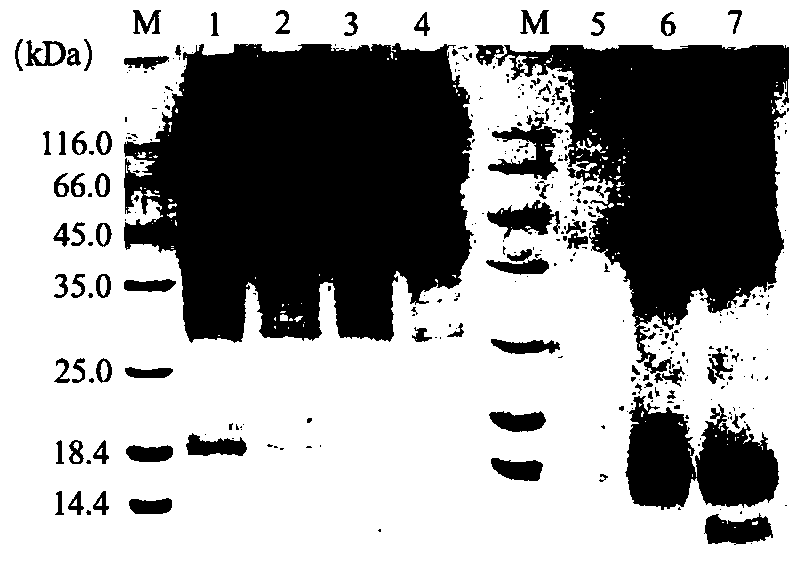Processing method for low-allergenic crabs based on directional modification for key amino acids
A processing method and amino acid technology, applied in the field of food processing, can solve the problems of ignoring the interaction of food substrates, unsuitable for industrialized expansion of production, etc., and achieve the effects of easy large-scale production, reducing allergenicity, and strong operability
- Summary
- Abstract
- Description
- Claims
- Application Information
AI Technical Summary
Problems solved by technology
Method used
Image
Examples
Embodiment 1
[0022] 1) Pre-treatment of crabs with salt: fresh and live crabs (blue crabs, portunus) as raw materials, remove sediment and dirt, rinse with clean water; put 0.5% salt water in the cooker in advance, and cook the crabs at 95-100°C 3min; the boiled crabs are rinsed with ice water and drained.
[0023] 2) Targeted modification of key amino acids: immerse crabs in 1.0% reducing sugar (pH 6.5) for 0.5h; the ratio of crabs to sugar water is 1:20 (w:v); the soaked crabs are placed in a pressure cooker and subjected to 0.08MPa pressure treatment 3min, to achieve the purpose of directional modification of the key amino acids of the antigenic epitope in the crab allergen.
[0024] 3) Product packaging: the processed crabs are split along the central axis, vacuum-packed and sterilized, and frozen at -20°C to obtain frozen crabs.
Embodiment 2
[0026] 1) Pre-treatment of crabs with salt: Fresh and live crabs (blue crabs, swimming crabs) are used as raw materials, remove sediment and dirt, rinse with clean water; put 1.0% salt water in the cooker in advance, and cook the crabs at 95-100°C 6min; the boiled crabs are rinsed with ice water and drained.
[0027] 2) Targeted modification of key amino acids: immerse crabs in 3.0% reducing sugar (pH 7.5) for 1.0 h; the ratio of crabs to sugar water is 1:15 (w:v); the soaked crabs are placed in a pressure cooker and subjected to 0.08MPa pressure treatment 6min, to achieve the purpose of directional modification of the key amino acids of the antigenic epitope in the crab allergen.
[0028] 3) Product packaging: the processed crabs are split along the central axis, vacuum-packed and sterilized, and frozen at -20°C to obtain frozen crabs.
Embodiment 3
[0030] 1) Pre-treatment of crabs with salt: Fresh and live crabs (blue crabs, swimming crabs) are used as raw materials, remove sediment and dirt, rinse with clean water; put 2.0% salt water in the cooker in advance, and cook the crabs at 95-100°C 9min; the boiled crabs are rinsed with ice water and drained.
[0031] 2) Targeted modification of key amino acids: immerse crabs in 5.0% reducing sugar (pH 8.5) for 2.0 hours; the ratio of crabs to sugar water is 1:10 (w:v); the soaked crabs are placed in a pressure cooker and subjected to 0.08MPa pressure treatment 9min, to achieve the purpose of directional modification of the key amino acids of the antigenic epitope in the crab allergen.
[0032] 3) Product packaging: the processed crabs are split along the central axis, vacuum-packed and sterilized, and frozen at -20°C to obtain frozen crabs.
PUM
 Login to View More
Login to View More Abstract
Description
Claims
Application Information
 Login to View More
Login to View More - R&D
- Intellectual Property
- Life Sciences
- Materials
- Tech Scout
- Unparalleled Data Quality
- Higher Quality Content
- 60% Fewer Hallucinations
Browse by: Latest US Patents, China's latest patents, Technical Efficacy Thesaurus, Application Domain, Technology Topic, Popular Technical Reports.
© 2025 PatSnap. All rights reserved.Legal|Privacy policy|Modern Slavery Act Transparency Statement|Sitemap|About US| Contact US: help@patsnap.com



